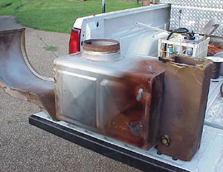
"I received an emergency service request from a good customer of mine recently," noted Wiggins. "She said her mother is elderly and living alone in a mobile home, and her cooling will not work. Her mother has had lung cancer and an operation has taken one of her lungs. On top of that, she has asthma that can be triggered by heat, dust, grasses, etc.
"So I went right away and found the breaker tripped to the outdoor unit. The entire underneath area of the mobile home was completely underwater from recent rains. I couldn't even get to the outdoor unit to check it because of all the water. I was able to see that the indoor gas furnace was in terrible condition and very old. I did not attempt to run and check it with the indoor temp already creeping into the low 90s.
"Mainly out of gut instinct I recommended the indoor gas furnace and evaporator coil be replaced. There was a good chance that the outdoor unit needed at least a compressor, so I quoted a price on that as well. To get her by until the replacement could be done I bought a small window unit and installed it in her bedroom so at least she and her dog could have some relief.

"I asked her when was the last time she had her furnace serviced and she told me just last winter. She went on to say the thermocouple needed replacing so she paid to have that done. I think a lot of technicians rely on observing flame behavior alone to check a heat exchanger's integrity. In this case one flame hits a deflector plate and goes every which direction. There isn't any good way to know if air is blowing on the flames or not just by observation. There is no doubt that other testing methods should be used.
"Her equipment was replaced and I decided to let her keep the window unit just for backup. She really appreciated that. Hopefully, with the new system she will be breathing easier for many more years to come."
Publication date: 06/28/2004

Report Abusive Comment